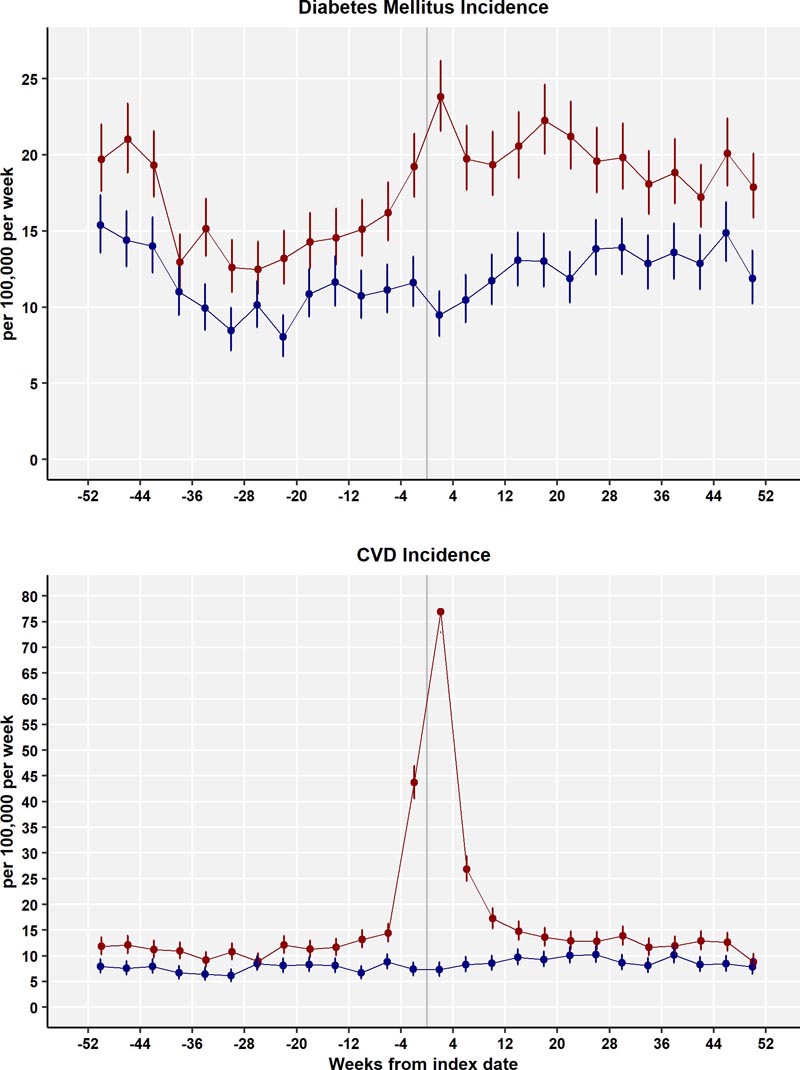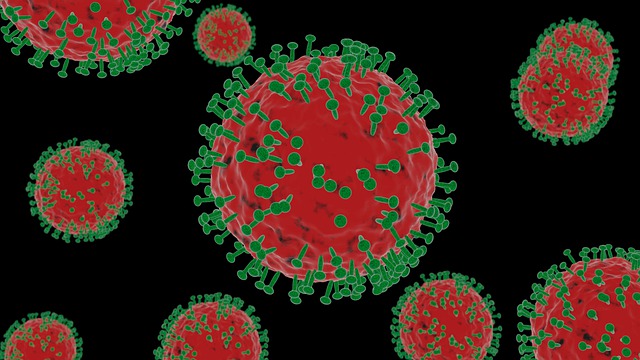Background
Acute coronavirus disease 2019 (COVID-19) has been associated with cardiovascular disease (CVD) and new-onset diabetes mellitus (DM), but it is not known whether COVID-19 has a long-term impact on cardiometabolic outcomes. This study aimed to determine whether the incidence of new DM and CVD increases over 12 months after COVID-19 compared to matched controls.
Methods and findings
Methods and findings
We conducted a cohort study from 2020 to 2021 analyzing electronic records from 1,356 family practices in the UK with a population of 13.4 million. Participants were 428,650 COVID-19 patients without DM or CVD who were individually matched to 428,650 control patients by age, sex, and family practice and followed until January 2022. Outcomes were incidence of DM and CVD.
A difference-in-difference analysis estimated the net effect of COVID-19 taking into account differences in baseline, age, ethnicity, smoking, body mass index (BMI), systolic blood pressure, Charlson score, index month, and matched set. .
Follow-up time was divided into 4 weeks from the index date (“acute COVID-19”), 5 to 12 weeks from the index date (“post-acute COVID-19”), and 13 to 52 weeks to from the index date (“prolonged COVID-19”). COVID-19").
The net incidence of DM increased in the first 4 weeks after COVID-19 (adjusted rate ratio, RR 1.81, 95% confidence interval (CI) 1.51 to 2.19) and remained elevated from 5 to 12 weeks (RR 1.27, 1.11 to 1.46), but not 13 to 52 weeks overall (1.07, 0.99 to 1.16).
Acute COVID-19 was associated with a net increase in the incidence of CVD (5.82, 4.82 to 7.03), including pulmonary embolism (RR 11.51, 7.07 to 18.73), arrhythmias atrial (6.44, 4.17 to 9.96) and venous thrombosis (5.43, 3.27 to 9.01).
The incidence of CVD decreased from 5 to 12 weeks (RR 1.49, 1.28 to 1.73) and showed a net decrease from 13 to 52 weeks (0.80, 0.73 to 0.88).
The analyzes were based on health record data and participants’ exposure and outcome status could have been misclassified.

Fig. 1. DM and CVD incidence rates (per 100,000 patient weeks) for COVID-19 patients (red) and controls (blue) over 4-week periods. Bars are 95% CIs. CI: confidence interval; COVID-19, Coronavirus disease 2019; CVD, cardiovascular disease; DM, diabetes mellitus.
Conclusions
- In this study, we found that CVD increased early after COVID-19, mainly due to pulmonary embolism, atrial arrhythmias, and venous thrombosis .
- The incidence of DM remained elevated for at least 12 weeks after COVID-19 before declining.
- People without pre-existing CVD or DM who have COVID-19 do not appear to have a long-term increase in the incidence of these conditions.
Author summary Why was this study done? ➢ Acute coronavirus disease 2019 (COVID-19) may be associated with cardiovascular complications and blood glucose disorders. ➢ It is not known whether patients who recover from COVID-19 continue to have an increased risk of cardiovascular disease (CVD) or diabetes mellitus (DM). ➢ This study aimed to find out if new diagnoses of DM and CVD increase during 12 months after COVID-19 compared to matched control patients who did not have COVID-19. What did the researchers find? ➢ We analyzed electronic records of 428,650 patients with COVID-19 who were matched with 428,650 control patients and followed until January 2022. We evaluated new diagnoses of DM and CVD up to 12 months after COVID-19 infection. We compared COVID-19 patients with controls and adjusted for baseline risk differences. ➢ DM diagnoses increased by 81% in acute COVID-19 cases and remained elevated by 27% 4 to 12 weeks after infection. ➢ Acute COVID-19 was associated with a 6-fold increase in cardiovascular diagnoses overall, including an 11-fold increase in pulmonary embolism, a 6-fold increase in atrial arrhythmias, and a 5-fold increase in thrombosis venous. CVD diagnoses decreased 4 to 12 weeks after COVID-19 and returned to baseline or lower levels 12 weeks to 1 year after infection. What do these findings mean? ➢ Acute COVID-19 is associated with an increased risk of cardiovascular disorders, but the risk generally returns to baseline levels soon after infection. ➢ The risk of new DM remains increased for at least 12 weeks after COVID-19 before decreasing. ➢ Patients recovering from COVID-19 should be advised to consider measures to reduce the risk of diabetes, including a healthy diet and exercise. ➢ People without pre-existing CVD or DM who have COVID-19 do not appear to have a long-term increase in the incidence of these conditions. |
Comments Science Media Center
Prof Kevin McConway, Emeritus Professor of Applied Statistics, The Open University, said:
“The increases in the risk of both cardiovascular disease and diabetes, in the first four weeks after a Covid diagnosis, are actually quite large. Of 100,000 patients who had Covid, approximately 300 had a new diagnosis of cardiovascular disease in the first four weeks after their Covid diagnosis. In 100,000 comparable control patients who did not have Covid, the number of new diagnoses of cardiovascular diseases in the corresponding time period was less than 30. The difference is not as marked for diabetes. Of 100,000 patients who had Covid, just under 100 had a new diagnosis of diabetes in the first four weeks after the Covid diagnosis, but for 100,000 controls, the corresponding number was slightly below 40. But all of these numbers at the same time The fewer they make clear that the majority of Covid patients do not actually become a new case of diabetes or cardiovascular disease.”
Professor Amitava Banerjee, Professor of Clinical Data Science and Honorary Consultant Cardiologist at the Institute of Health Informatics, UCL, said:
“In terms of novelty, there have been analyzes that show an increased risk of both increased cardiovascular disease and increased cardiometabolic risk (diabetes and CVD) after COVID. This large, well-conducted electronic health record study supports findings from other research in the UK and other countries showing increased risk of cardiovascular disease and diabetes after COVID. These new analyzes suggest a slightly increased risk in the entire population in the first weeks after COVID, but a higher risk in certain people, such as those with pre-existing heart disease or diabetes. The underlying mechanism of the increased risk is unclear and more research is needed. In addition to the direct effects of COVID-19, the pandemic has negatively affected the diagnosis and treatment of heart disease, diabetes and other underlying conditions, albeit indirectly. “Once again, science supports avoiding SARS-CoV-2 infection at the individual and population level, whenever possible.”
















